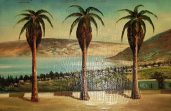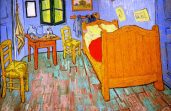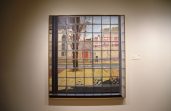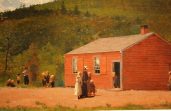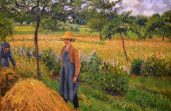March 2010
Lagniappe
Recently, we went to Avery Island, home to Tabasco pepper sauce. For all of one dollar, per car, you may take a mini tour of the factory, visit the museum, see a video, and enjoy more free samples than I have ever before been offered. I will say that we enjoyed everything except the jalapeño and Tabasco flavored ice-creams, which while interesting, were not quite to our taste.
This was one of those stops which I decided to make based on a friend, Melody’s earlier visit. I remember her having gone there, maybe fifteen years ago, and commenting on what a nice time she had. The island is about an hour and half drive from New Orleans. I would not make a separate trip to Louisiana, just to go to Avery Island, but for us it was a small detour, and worth the stop.
Tabasco pepper sauce has been made by the McIlhenny family for six generations, beginning in 1868, and the company is still entirely in the hands of the family which oversees all aspects of the business. During the tour, you are told that Edmund McIlhenny was originally given a few Tabasco peppers, from which he harvested the seeds. He planted the peppers on Avery Island, where he had moved to, after he married. During the Civil War, the family went to Texas, to escape the Union’s determination to destroy the salt mines, on the island. After the war, he returned to find that his peppers had continued producing.
He began to experiment with the peppers, eventually making a simple sauce of ripened peppers, salt, and vinegar. Like Paul Newman, after him, he began to give away samples of his sauce, to his friends and families, who requested more! Eventually, using old perfume bottles, he began to bottle and sell the sauce. The secret to the sauce is that peppers are picked which they have ripened to a perfect red. To ensure that the peppers are picked at their ripest, the workers, who hand picks the peppers, are given a small red stick which is painted the exact color which the pepper must be. It was at this point in the tour when I began to question if Tabasco sauce was made in America. I wondered what people were paid to hand pick each pepper?
Up until the 1970’s all of the peppers, for the sauce, were actually grown on Avery Island; that is no longer the case. During the tour they mentioned that seeds are selected from the finest plants; brought back to their green houses and the plants, for the next years’ harvest, are started during the winter. When the plants are ready to be put in the ground, they are packed and shipped to various countries in Central and South America, where the plants are grown and the peppers harvested. The guide mentioned that the change had come about because the weather was more reliable in the south. Perhaps, but I find it hard to believe that it was not a choice motivated by economics more so than wind and rain. She said, however, that the sauce was still bottled on the island.
The peppers are crushed the day they are picked, and sprinkled with salt, from Avery Island. The pepper mash is then poured into Jack Daniel barrels, which the distillery can legally only use once. After three years of aging in oak barrels, the mash is strained, vinegar is added, and the mixture is then stirred for several days before being bottled and sold around the world. It is quite a story.
Walking around the small island, which is also a bird sanctuary, it is impossible not to be impressed with American ingenuity. Not only has an entire empire been built around a small red pepper; but the brilliant marketing people have seen fit to welcome visitors basically for free. The one dollar per car fee goes toward helping to maintain the bird sanctuary. Before watching the video, on the tour, we were each handed three very cute, tiny bottles of Tabasco sauce, in what our guide says was lagniappe – a little something extra, akin to a bakers dozen. I happen to love free stuff, I really do not know why; but even something I do not really want or need appeals to me when it is free. As our guide gave us our little bottles, she built instant good will.
After the tour, we of course walked over to the gift store, or country store, as they called it, to enjoy free samples of their various sauces and condiments, chili, soda, and ice-cream. Not having paid a fifteen or twenty dollar admission fee to the factory, or another five or ten dollars to park our car, we happily looked around the shop packed with everything from Tabasco flavored Spam and popcorn to pepper adorned aprons and lamps. Yes, it was impossible not to shop in the little store – pepper jelly will be in Mother’s next box – and yes, perhaps surprisingly, but pepper jelly is actually very good.
We were quite taken with the entire operation, and as we walked around the island, I debated whether or not Tabasco sauce was made in America. Initially, upon our arrival, I had told Kate: Oh, great, this will be a Made in America product, which I can mention, on these pages. But the more I thought about the process the more I questioned Tabasco’s status. Yes, it was being bottled locally, and yes its mother pepper plants all came from the Island; but what about the jobs given to the farmers and pickers in Central and South America, which could be given to men and women in the United States? Is Tabasco sauce another by product of globalization or capitalism? If the sauce is sold throughout the world, which it is, is it wrong for the jobs it creates to also be shared with the rest of the world? It had been a nice diversion, and I am glad we stopped; but I left without answers.
American school boards, across the country, which have already made massive cuts in electives, like physical education, music, and art, shortened school days, and standards, are now talking about shortening school weeks to four days. The mortgage crisis, no matter who is to blame is actually leaving working American women and men homeless; while unemployment numbers continue to grow. America is in a financial crisis.
Henry Ford, founder of Ford motors, ingeniously understood two things. First, he grasped the value of mass production and the assembly line. Secondly, he realized that in order for his company to succeed, the workers on those assembly lines needed to be able to purchase the product they were making. American businessmen have been successful in America because of Americans, which in no way detracts from the economic impact of import and export divisions in said companies. As a capitalist, I applaud them all, however, as a concerned citizen, I am wondering if it is not time for successful American companies to look inward and see what business can do for America?
I concede that there are advantages to diversifying investments and to protecting your pepper crop against unpredictable weather; but I also wonder if there is room to bring some of those oversee jobs home, at least for a bit. That is all for now.
~ M ~
March 2010
In the Garden
The more one gardens, the more one learns; and the more one learns, the more one realizes how little they know. I suppose the whole of life is like that. ~Vita Sackville-West~
It has been a terribly long winter, and spring seems more elusive than ever. Today I walked outside to survey my sub-tropical garden, which has barely survived this winter of our discontent. I have not seen my yard looking this sad since it was hit by Hurricane Wilma. There was one rose in full bloom. Hope? Maybe, it seems that my chenille plant has died and I have serious doubts that the coconut tree will make it.
I said yes to purchasing our house for two reasons. One, it was affordable. I told Kate I was not willing to take on a mortgage payment that could not be made with us working at McDonalds, and secondly because the yard was barren. I looked out at all of that grass, and I felt that I had a blank canvas that I could work with – I was naïve and a bit over optimistic.
Initially, I set about pulling out grass as if I had a staff of seventy. I planted a vegetable, an herb, a cut flower, and succulent garden, plus fruit and shade trees and flowering shrubs. There was a moment when I looked out at our hard work and finally felt like it was finished. I had made walking paths, sitting and sunning areas; I added water features, and incorporated all of the lovely bromeliads and orchids which I garnered from the many garden clubs I joined. But as in other aspects of life, perfect only lasted for a few days, then weeds began to overwhelm me, and everything decided to be fruitful and multiply faster than I could find other gardeners to share with.
I remember Phil, my neighbor, having told me about all the plants he had once had in his yard, and wondering where they had all gone. I was beginning to understand. It is easy to envision and even plant a garden; it is the maintaining which takes its toll, again very much like life in general.
I love being in the garden. I love getting my hands dirty and feeling the hot sun beating down on me. I love planting a seed and watching it become a plant, providing flowers and food. I will admit pruning is an acquired taste. I use to feel very bad cutting things back, but the cuts are necessary to produce growth – just like in life. There is something quite divine about sitting down in nature. You really do feel closer to God. Yet, a garden requires a special kind of commitment. Like all living entities a garden demands constant attention.
In the last year, we have been reexamining our lives, goals, dreams, and desires. During this process, we have spent many days sitting outside, enjoying the garden while we planned changes to our life and landscape. My garden needed of me daily. Initially, I was happy to oblige. I kept thinking once I finished the garden, I would be able to move on, but that was untrue. The garden became like a high maintenance friend, and though I was saddened by my choice, I decided to replace some of the sod I had so meticulously pulled out years before.
When I first told Kate that I was going to sod the vegetable garden, she looked at me in total disbelief. After all of the work involved in ripping out the sod, to create the vegetable garden, I was going to buy and replant grass? What about all of the natural stones and boulders, which Kate had hauled home to create our gardens boarders? How about all of time and energy spent composting to enrich the vegetables garden’s soil? Graciously, she did not mention the money which had gone into plants, food, manure, snail bait, bug sprays and garden art. I was overwhelmed with guilt.
I explained to Kate that unlike the vegetable gardens in California, that were often entirely in containers, depending on where we lived, and which endlessly produced a bounty of tomatoes, onions, garlic, squash, peppers, artichokes, chard, lettuce, brussels sprouts, spinach, and eggplant, in Florida, spraying for bugs and fungus nullified the benefits of the homegrown produce. Also, I wanted my freedom back. The gardens demands had become too great. I had given up the Master Gardening, though it is a great organization, and the garden clubs. Nevertheless, for weeks we debated my plans.
We tried to hire help for our yard, which was useless. I would patiently ask if they understood what a coriander seedling looked like, as I explained that the herb was naturalized in my yard and when weeding it should not be pulled. Yes, they would swear, as they went out decimated my herb crops. I then decided I would try to teach someone how to work in my yard. After several attempts with paid apprentices who failed to comprehend my goals, I finally decided it was time to act. I was sure.
There had been a time when I envisioned every blade of grass being plucked from the yard. I had wanted to create this beautiful garden which concealed me from the world, but I changed and change was good. I was ready to go back into the world, and no longer wanted anything which inhibited my movement. I loved the garden, but it had become too much. I needed a garden I could control, and not a garden which controlled me.
The process of reclaiming portions of the lawn has gone smoothly. Kate surrendered to my new plan, and every change has been thoroughly mulled over. My garden is now a third smaller than it was. Instead of having separate plots for vegetables, herbs, and flowers, I have now created a less traditional and formal garden where herbs and flowers happily coexist with the fig tree and roses are tucked in with succulents and bromeliads.
Sitting outside and surveying the damage done by so many cold days, I feel a bit sad. I wondered if I could have done more to save the plants from the frosty nights? I walk along the laid out paths, instinctively bending down to pull weeds, clipping spent branches, and making notes of the work that needs to be done. I quickly fill up a trash can with garden debris. I had not planned to spend time in the garden today; I am still fighting my “cold” and lack the required energy. Yet, the garden has drawn me in, and I have surrendered. I am not unhappy with my choice. There is no better place to sit and read than in my shaded “orchid” garden. I am tired, and it is cold. But I sit outside and contemplate the things which have changed, in our life and the garden.
Many years ago, I heard an interview with America’s poet laureate. I do not recall the mans name. He had lived one of those perfect lives, at least to me, which involved travel and adventure. The interview was conducted in his Hawaiian garden, where he not only spoke of poetry, but of the many plants in his garden. After a while, the poet was asked why he had finally settled down, and he answered that a gardener eventually puts down roots. I believe the poet was in his 80’s. I am still a few years shy of 80.
I sit a while longer. I do not regret trying to simplify my garden. I want more freedom to travel and have adventures. I have deliberately set about to uncomplicate my life and try to regain some of those care free feelings of my youth; but I do love my orchids – which are actually rather low maintenance. Kate and I have built a life, a home, and a garden. Most of what we built has been good, but there are things which once seemed right that no longer work. We do not have to be married to all of our choices. It is okay to embrace change.
My yard really is in need of attention, but Kate calls me from Baltimore, and asks if I would like to go to Dallas. It has been a long time since we were in Dallas. I would like to go to Dallas. The yard will have to wait; I am going to go pack. That is all for now.
~ M ~
March 2010
Las Vegas
Kate and I are not “party” people and we do not gamble; but we do love neon! I have tagged along with Kate, on a business trip, to Las Vegas. It is my first time flying into Vegas. We land at McCarran International Airport, which was once Alamo Airport, founded by Davy Crockett descendent George Crockett, and his wife Peg. The airport is abuzz with activity and excitement and we are willingly swept up in the rush of possibility which Las Vegas represents, despite us both battling colds.
I have been trying to think when it was that we were last here, but memory fails. It has been a good long while. I think it must have been a drive thru on some road trip, but I do know the scenery has certainly changed.
After checking into The Signature, at the MGM Grand, we go out to “The Strip”, Las Vegas Boulevard, for a much needed walk. I react like the quintessential tourist, it is impossible not to react. As we step out of the massive MGM Grand, we are met by replicas of the Statue of Liberty, which I knew was here, but the Chrysler Building and Brooklyn Bridge? I begin to snap photographs, and gawk at the scenery. It is colder than we wish, but it feels good to walk the crowded streets. I am amazed at how different it is from what I recall. This is not the Las Vegas of my youth, or even of my Los Angeles days. If you live in Los Angeles you come to Vegas. It is about a four hour drive, much of which use to be spent in a fairly vacant desert, on Interstate 15. Now the darkness has been permeated by explosive growth. But I am certain I am not alone in remembering what it use to be like to suddenly see the glow of the far off lights which drew you in to the valley.
It was water, the most precious of commodities, in the desert, which first brought Las Vegas to the attention of those seeking new vistas. The water brought the railroad, the requisite element for any town in the West, which hoped to matter. In March of 1931, gambling is legalized in Nevada, and construction begins on the Hoover Dam. We will not see the Hoover Dam on this trip, but I highly recommend that tour, which we took at least ten years back. Nor will we venture to the Grand Canyon, despite all of the advertizing, as we have already made several trips there as well.
The first hotel-casino, El Rancho Vegas, will open on Las Vegas Boulevard in 1941, during World War II. It is the brain child of Thomas Hull, owner of the Roosevelt Hotel, in Los Angeles, and like those resorts which will follow; it has a theme – the wild west! By the end of the war, tourism will become the primary source of income for the city, which will be revisited by the many GI’s who were stationed in the area, during the war. This city which is constantly evolving and reinventing itself is no longer simply a lay over for Spanish traders or Mormon pioneers.
I do remember my first trip to Las Vegas, in 1976. My father was preaching at an interdenominational revival, and the meetings were being held at the Las Vegas Convention Center. For some reason, only I was traveling with him, and therefore instead of Joy singing, which she did beautifully and with ease, he asked me to do a solo. What a disaster! I had the worst stage fright of my life, as I stood on an enormous platform and looked out at the congregation; I froze and was barely audible. The good news was that he did not make me sing for the rest of the revival. Oddly, I was next in Vegas with him, to see Dean Martin, at the old MGM Grand.
What an incredibly good trip that was. I had mentioned to my father that I really wanted to see Dean Martin, whom I madly loved – and still do; my father answered that Martin was playing in Las Vegas, it was just that simple. I remember Caroline coming along on that trip, but not being allowed into the show, as she was too young. I think she ended up playing at Circus Circus. It was a dream come true.
Kate and I grab something to eat, and continue our walk around the almost built to scale world of Las Vegas. I do not remember having seen the Paris or Venetian. I wonder if I am witnessing a lack of imagination or pure genius? The sun is still shining but the streets are filled with people drinking cocktails out of plastic Eifel Towers and yard stick long tubes. There are children in strollers and older women resting tired feet where they can. New Orleans Mardi Gras beads adorn the necks of both women and men, and there are puka shell and kukui nut necklaces for sell, as if we were strolling along Waikiki beach. We walk several miles before surrendering to our fever and heading back to our luxurious new “home” and room service.
For the next several days, work will dominate Kate’s life; but the streets call my name. I am in my element, not Las Vegas, but unexplored landscapes. I am happy. As I walk along the boulevard, stopping in shops which mostly sell the same things, and weaving in and out of the many hotels which are the cities main attraction, I make a rather monumental discovery; I am living the life I want. The realization at first surprises me, and I almost feel guilty admitting how happy I am. It is not this city or any one place, but it is the discovery process which I love and need. Every night I come home and up load my pictures, and walk Kate through my day. Over dinner, I rattle off the inconsequential facts that I have learned, that I find stimulating, and I make notes about what I further want to investigate. I write down my observations and the various conversations I have had with total strangers, and think that someday they will work their way into a short story or novel.
I like waking up in a new place. It is impossible to escape. I was born on a road trip, and Kate and I started our life together on the road – our first home was room 110 in the Upland Best Western, and we were happy there – until they went bankrupt, and we ended up living in a tent. I worked the front desk and made just enough money to pay our room rent and buy food, much of which came from a vending machine; but we were happy. I love the prospect of discovering the unknown.
Having exhaustively explored the strip, to the north of the MGM, I cross Tropicana Avenue and check out the Excalibur and company, to the south. I debate whether or not to venture into the Tropicana Hotel, where guest are arriving, and decide to continue on toward the fairy tale castle which is the Excalibur. Like all of the other hotels I have seen this week, it is an impressive creation which blends fantasy and practicality. In Las Vegas pyramids house the living plebs instead of deceased royalty. I walk through the hotels and their grounds, until I quite literally reach the end.
I continue walking past the end. I am searching for the original Betty Wills “Welcome to Fabulous Las Vegas” sign, designed in 1959, and sold to the county for a mere four thousand dollars. Its iconic image is plastered on everything from t-shirts to porcelain piggy banks; as she viewed it as her gift to the city, and chose not to copyright the symbolic sign. I am searching for an authentic Las Vegas moment, I want to find the sign, but I do not. Instead, I look back; from I have come and find it difficult to believe that I am still on the same street, which I decide to again cross.
Nestled in the shadow of the mammoth resorts, I find the remnants of what were once those thriving motels that lined American highways, especially in the West, in dusty towns with squeaky signs. Those little places represented possibility for a young country on the move, where you drove yourself in, signed a registry, laid down your cash, and were given a key, as you were wished a good evening. For the next 24 hours, you had a new home. No one bothered you, and you could be anyone you chose to be – Mr. and Mrs. Smith or the Parkers from down Maine. You would walk to a diner for dinner, order an open faced roast beef sandwich, and lots of coffee; and afterwards sit out by the pool counting the stars before searching out a leaky ice machine and turning in for the night. Ah, it is not just the romantic in me – I remember.
I arrive at the beginning of the scenic route and continue to walk back toward the Tropicana. This time I decide that I will go in, as I have already strolled through so many hotels, why not one more. The moment I walk through the doors, I feel that I have stepped back in time. This is what I remember. I see evidence of construction in the back, and signs asking that we pardon the dust and inconvenience; I smile and enter further in to investigate. I have arrived just in time; it seems the Tropicana too will soon be changing. Off toward my right I spy Wayne Newton’s name, and I walk toward the lights, like a good tourist. He is playing at the hotel, “Once Before I Go,” is the name of the show, and next to the venue is a shop selling and displaying his memorabilia. I was looking for an authentic Las Vegas moment, and I almost passed it by.
It was perfect. Small, and not overly sophisticated, but still it touched upon a life. An older woman, with rhinestone hearts and American flags, sat behind the counter and wanted to chat. I asked if I could take pictures, she said why of course. I had to buy a magnet. I left feeling satisfied. I saw what I came for.
Had I not turned around, I would have eventually run into the sign. Instead, we will rent a car, and explore down town Las Vegas, where the first neon sign went up in 1929. We will see the Blackhawk, private car number 92, which transported Annie Oakley, Buffalo Bill Cody, and Theodore Roosevelt around the West. As well as The Portal, which use to serve as the center for cultural events in Las Vegas, and enjoy a self-guided tour, of the outdoor Neon Museum which graces the city.
Kate will drop me off, with much glee, to photograph what will turn out to be the wrong sign, and then cleverly pick me up, at a wedding chapel, when the police circle around me, in the middle of the street. I will try to convince myself that in my dyslexic state I wrote 5100 South Las Vegas Boulevard, when it should have been 1500 South Las Vegas Boulevard. Luckily, Kate will insist that we also check out the 5100 address, just in case, and we shall find the right sign – the one on the right. We sit across the street from the airport, watching the planes land, which seem close enough to touch. It has been a good trip.
We are on our way home. The sun is setting behind us, as we float on a bed of white and grey clouds. The horizon is striped with bright orange and yellow streaks, and capped with a pale, fading white layer and a darkening blue sky. Thirty thousand feet below there are pockets of orange and white lights, over the expansive landscape that is the West. I am glad we came and that we know this place. Neither of us feels ready to go home, but we must. That is all for now.








